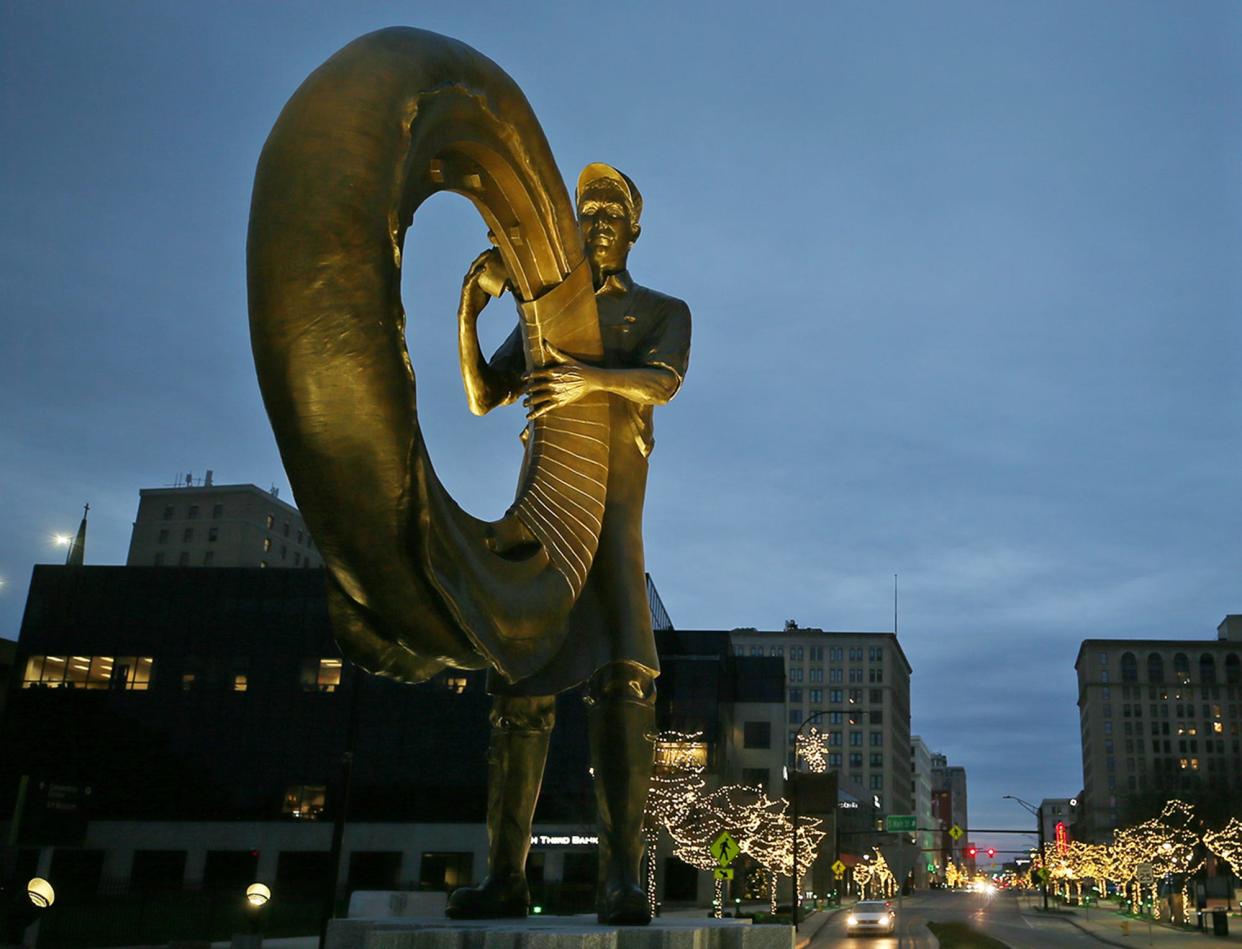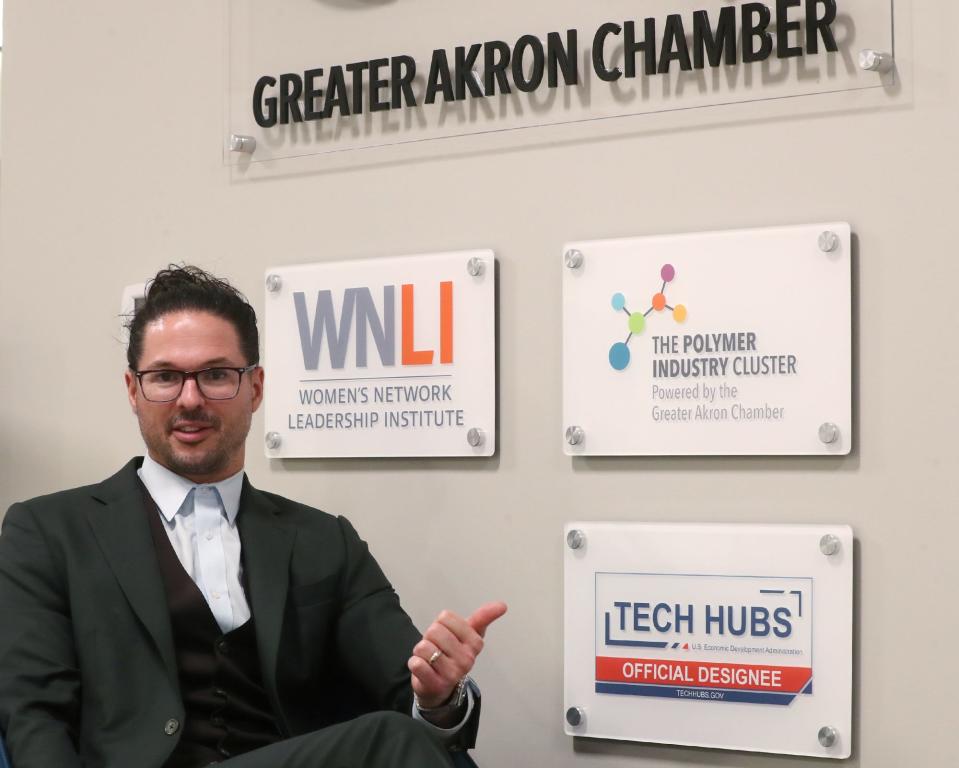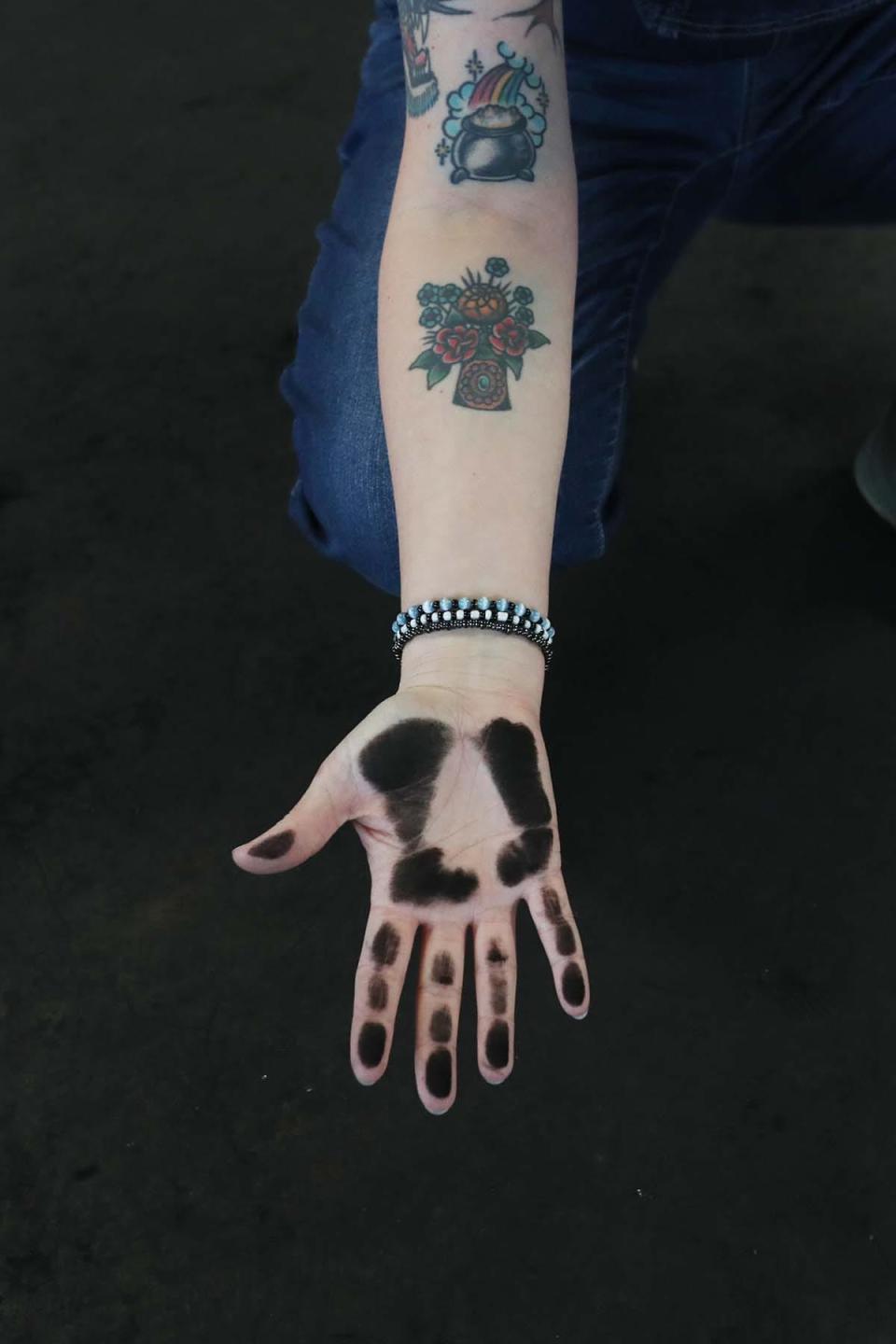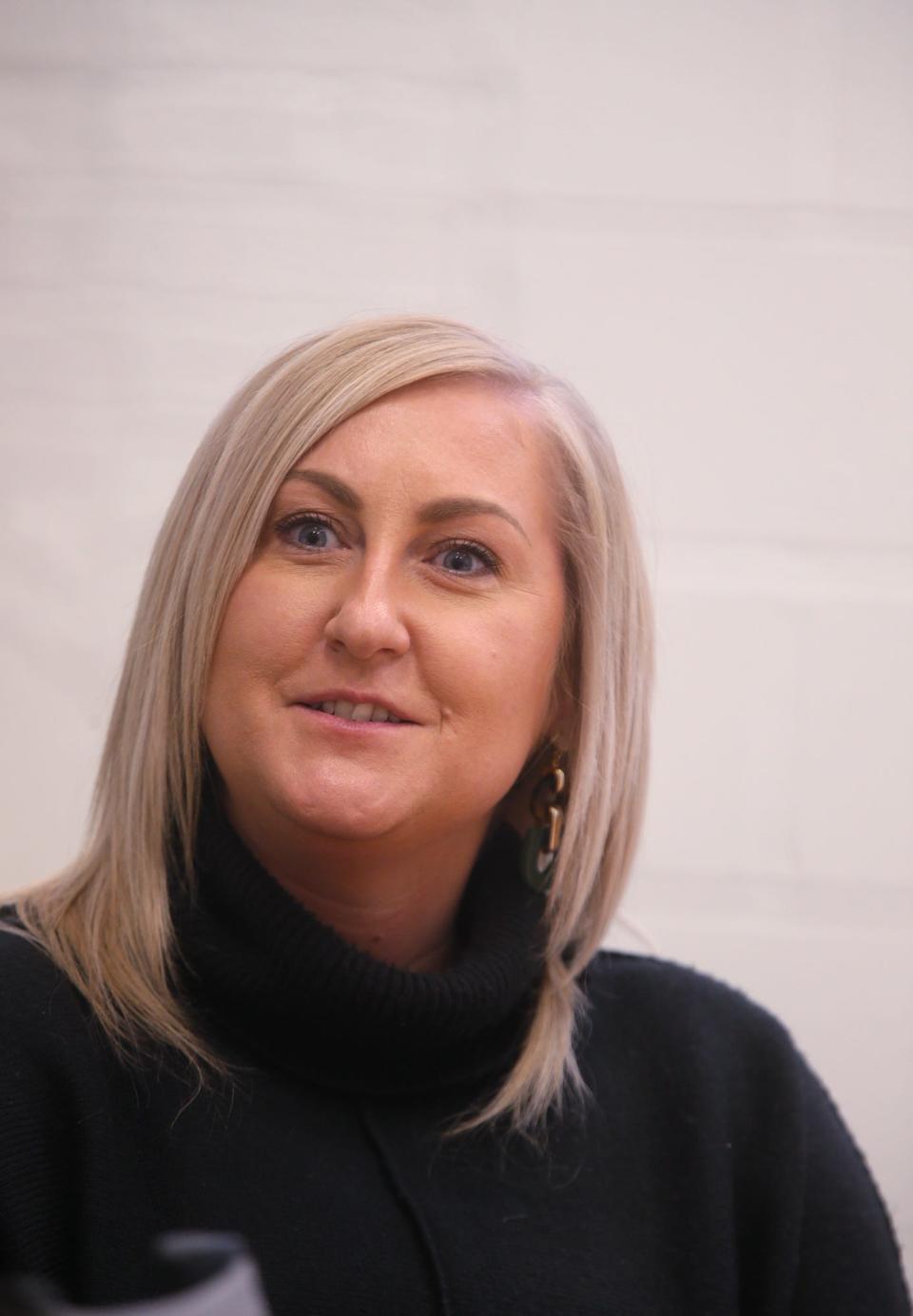Akron aims to bounce back, using its rubber and plastics history as springboard to future

Could Akron be the rubber capital of the world – again?
Not just rubber for tires, but for all the polymers and plastics that create so much of what we depend on today, from the toothbrush you pick up in the morning to the light switch you turn off at night, and even the stent that might keep your blood safely flowing through your heart 24-7.
Think big.
Think really big.
Leaders say Greater Akron could soon drive a tidal wave of innovation spurred by millions of dollars in new state and federal investments aimed at helping local businesses and research institutes compete globally.
The government funding targets areas of Ohio and the country where existing science and industry expertise has largely been overlooked by the tech revolution that’s been a boon to many cities on the U.S. coasts.
In Akron, that expertise remains polymers and plastics.
While the collapse of tire manufacturing in the 1970s and 1980s killed about 50,000 good-paying jobs at large manufacturing plants, the rubber and plastics industry here continues to percolate.
There are about 150 polymer-related companies in Summit and Portage counties, and 350 more throughout Northeast Ohio, said Brian Anderson, the vice president of research for the Greater Akron Chamber.
Additionally, both Bridgestone and Goodyear have research and development facilities in Akron. And the University of Akron, with its 12-story, mirrored polymer building, remains a world academic leader in polymer science and engineering.
Local leaders and economic development groups are for the first time trying to bring all of that expertise together to figure out how Greater Akron can work in new ways to drive discovery.
They call it the Akron Polymer Industry Cluster.
Much of its focus is developing safer and more sustainable products for people, animals and the environment.
Could Akron scientists, for example, discover how to make car tires 100% recyclable so that they’re never again dumped on the side of the road or piled in a landfill?
Or could they develop safer alternatives to common toxic chemicals like polyvinyl chloride that polluted the air, water and ground in East Palestine earlier this year after a catastrophic train derailment?
Anderson – who leads the polymer cluster out of the Greater Akron Chamber of Commerce – said the group is confident it will soon receive up to $35 million in new state Innovation Hub funding.
But Akron’s polymer cluster could receive even more in separate federal funding.
In October, the U.S. Department of Commerce named Akron as one of 31 new federal tech hubs across the country.
Akron – which competed against more than 400 other clusters of expertise – is the only hub focused on sustainable polymers and plastics and the only hub chosen in Ohio. Partners in the hub also include Kent State and Case Western Reserve universities, along with NASA Glenn Research Center.
The polymer cluster will now compete for about $500 million in funding from the bipartisan CHIPS and Science Act. Between five to 10 of the hubs will receive up to $75 million each.

Additional rounds of funding are expected. But even without the cash, the federal tech hub designation carries with it gravitas, leaders say, a signal that Greater Akron is the place to be if you want to discover, produce or invest in sustainable polymers or plastics.
Hans Dorfi, senior vice president of engineering at Bridgestone Americas and chairman of Bounce Innovation Hub, compared it to a mountain climb.
“The hard part is still to come,” Dorfi said. “It’s like when you get invited to scale a mountain. You know you’re part of that party, but you still have to scale that mountain.”
To help fund that polymer climb, the federal government in October also awarded the polymer cluster a $400,000 strategy development grant to help organize a staff, establish goals and apply for more funding.
If Akron can reassert itself as the leader in the next generation of polymers and plastics, economists say there could be a cascading bounty of riches that benefits everyone in Northeast Ohio.
New discoveries could create an array of good-paying jobs for everyone from high school graduates to Ph.D.s in the polymer and plastics industry, along with all the industries they touch, from automotive and health care to semiconductor chips and aerospace.
That, in turn, would create more opportunities for start-up companies, accountants, lawyers, restaurant workers and myriad others who would benefit from any growing industry.
And that means Akron – which was the fastest-growing city in the U.S. between 1910 and 1920, its population soaring from about 69,000 to 208,000 – might get a second act, drawing new generations to come work in the Rubber City.
Back to the future?

This is not the first time the federal government has poured money into Akron’s polymer industry.
In 1939, when World War II began overseas, Akron’s tire factories were humming. But there was a problem: U.S. tire makers depended on natural material from rubber trees that were grown exclusively in Southeast Asia.
The war cut off that supply and, by the end of 1939, the U.S. had less than half of the stock available during the previous half of the decade, according to the Library of Congress.
Without rubber, there would be no tires for American cars. But more importantly, there would be no tires for U.S. war planes which would soon square off against those of Germany and Japan.
The German government, in its run-up to war, had already developed and switched to synthetic rubber, giving it an enormous advantage. In December 1940, a year before the Japanese bombed Pearl Harbor, the U.S. launched an ambitious plan to catch up.
A sort of forerunner to today’s Akron tech hub was quickly established. Under U.S. government sponsorship, a consortium of researchers in government, academic and industrial laboratories in Akron and some other U.S. locations quickly developed synthetic rubber and went on to manufacture enough to meet the needs of the U.S. and its allies during the war.
That war-time investment had far-reaching implications, spilling over into innovations in other industries, including energy, transportation and consumer products.
More U.S. government research and development followed during the space race to reach the moon in the 1950s and 1960s, said Mark Muro, a senior fellow at Brookings Institution’s Metropolitan Policy Program.
That federal spending built vibrant Sun Belt economies in the south, he said.
“These kinds of investments are a big part of American history, but we love to hate them,” said Muro, who co-authored a report that has served as a road map for the new U.S. government tech hub initiative.
For much of the 20th century, the U.S. government led the world in spending on investment research and development, but it began to decline in the 1980s, falling about 16% between 1987 and 1994. That investment fell another 16% between 2009 and 2016, according to the Congressional Research Service.
As government spending dropped, the economy was splitting. On the coasts, the tech revolution was booming. But much of the center of the country, in places like Akron, had local economies that were stagnant or slipping.
“One of the most unfortunate side effects of that uneven economy is many places feel left behind and feel extremely frustrated…and are rightly frustrated,” Muro said.
Neither market forces nor bottom-up economic development efforts are likely to close that divide without federal intervention, Muro and his Brookings colleagues concluded.
In December 2019, they urged lawmakers to fund the transformation of a short list of “heartland” metro areas into self-sustaining growth centers that would benefit their surrounding regions.
Akron – along with Cleveland, Columbus, Cincinnati and Dayton – were on Brookings’ list of about 30 potential growth centers.
Each had existing assets to build on, including the number of people with STEM doctoral degrees, the number of U.S. patents generated and how much money was being spent on university research.
“What is important is that there is a body of research that shows the right kind of investments in the right kind of technology make sense in places that already have a foundation in a specialty,” Muro said.
“Tucson, Arizona, is not going to be a polymer or materials center,” he added. Akron’s “long pre-history in polymers and solid toehold are two of the predictors for success.”
In December 2022, the U.S. Congress passed the CHIPS and Science Act, which combined two bipartisan bills designed to boost investment in domestic tech through the sort of growth centers outlined by Brookings. The act also aims to bring semiconductor manufacturing back to the U.S. to compete with China.
The timing for Akron to compete for one of the hubs was near perfect.
What is a polymer?
The word “polymer” comes from the Greek poly, which means "many."
Polymers are made up of many small molecules called monomers that are linked together to form chemical chains.
Some polymers are natural: wool, cotton, silk, and even the DNA that makes up living things.
Others are man-made, or synthetic. These polymers are made up of complicated chains of atoms that are generally much longer than those in nature.
The first synthetic polymer was invented in 1869 by John Wesley Hyatt. He created a substitute for ivory from elephant tusks, which was being used at the time to make billiard balls.
Man-made polymers, like synthetic tires and plastics, soared after WWII, according to the National Institute of Health, and now make up many of the things we depend on: clothing, cups, fiberglass, the silicone tips on your earbuds, plastic bags, paints, epoxy glue, foam cushions and silicone heart valves.
In Akron, scientists who had worked on the WWII synthetic rubber project saw the value of this work and helped form the Institute of Rubber Research, which opened at the University of Akron in 1956. It would ultimately evolve into the UA School of Polymer Science and Polymer Engineering.
Polymer-related companies, meanwhile, took root in Greater Akron.
How the Akron’s Polymer Industry Cluster was born
In 2017, Elevate Greater Akron released findings from an extensive economic development analysis.
It described the “region’s economy as neither distressed nor dynamic but facing strong headwinds from the rapidly changing global economy.”
“In short, Akron’s polymer industry has the makings of a potentially successful and unique cluster effort that could give the region a toehold in a new set of growing, adjacent markets” the report said. “But the region has never truly explored or acted upon this potential.”
The polymer cluster, slowed by the pandemic, fully kicked off in early 2021.
“Early on, we were kind of modest. We asked if there was even enough here to stand up a cluster,” said Anderson, who has led the polymer cluster through his work with the Greater Akron Chamber.
“We wanted to be really sure that if we go big on something, it’s a good bet,“ Anderson said. “There have been attempts in the past that haven’t gone as hoped.”
In 1995, for example, the National Inventors Hall of Fame opened in downtown Akron aiming to encourage innovation. It lost so much money that it moved its museum to Virginia in 2008, while its headquarters were relocated to North Canton. The Akron building now houses an Akron Public Schools STEM school.
The same year NIHF moved out of Akron, local leaders tried to jump-start the city’s economy through medicine. They launched the Austen BioInnovation Institute with more than $70 million in support from Akron hospitals, universities and foundation grants.
That flopped, too.
But the polymer cluster is different, leaders say.
It’s not just a local effort. It’s fully backed by state and federal leaders and money.
Just as importantly, leaders say, plastics and polymers are already Greater Akron’s speciality, so there’s an existing deep well of knowledge.

The polymer industry is Ohio’s largest industry, with more than 72,000 employees in 996 companies contributing more than $40 billion to Ohio’s GDP in 2023, according to the chamber.
Most of the manufacturers, along with academic and business research facilities, are located in Northeast Ohio.
A Polymer Industry Advisory Counsel – a coalition of more than 40 companies, academic institutions, economic development organizations and representatives from the polymer cluster – has been meeting monthly since April 2021 about what the cluster needs to thrive.
Anderson said the group estimates it will take about $200 million in investments over the next 10 to 20 years to lift the polymer research and manufacturing here to its full potential.
The return is estimated to be in the billions of dollars, he said.
Good news for Greater Akron

The good news arrived on a Sunday afternoon in October.
Bounce CEO Jessica Sublett was riding in a car with her husband when Brian Anderson from the polymer cluster called.
“This feels weird. Why would he be calling now?” Sublett told her husband. “I better answer this.”
Anderson asked Sublett if she had time the next day for a teleconference call with the White House.
Akron, after two years of meetings and strategizing about a polymer cluster, had a win – it was about to be designated one of 31 tech hubs across the country.
U.S. President Joe Biden made the announcement during a press conference the next day flanked by myriad computer screens that included Sublett and others involved in the regional hubs.
“The U.S. will lead the world again in innovation across the board,” Biden said.
The polymer cluster is now working on its first federal hub funding application and narrowing down projects, which must focus on sustainable rubber and plastics. The application for as much as $75 million in federal funding is due in February, with winners announced over the summer.
Sublett – an attorney with expertise in technology transfer and intellectual property – said the designation also could have multiple positive ripple effects, including drawing more venture capital funding for polymers start ups.
People driving Akron’s polymer cluster say similar programs have already helped other post-industrial U.S. cities, including Syracuse, New York.
There, a cluster built around drone technology more than a decade ago ultimately helped lead Micron this year to announce it was building a $100 billion microchip facility in Syracuse that will bring up to 9,000 jobs.
Sublett said Syracuse’s equivalent to Akron’s Bounce now recruits drone talent from around the world.
Similar to Akron’s, Syracuse’s cluster started with people trying to figure out how to leverage the local assets and know-how they already had, Anderson said.
The approach led to state and federal investment – and success, he said.
Brookings’ Muro urged Akron to forge ahead with polymers and plastics.
“This is a special moment in which global investment is flowing toward places like Ohio, and there should be a sense of commitment to local strength,” he said.
“If you want to transform an economy,” he said, “it takes greater investment.”
This article originally appeared on Akron Beacon Journal: Akron named 1 of 31 US tech hubs. What it means for the region

